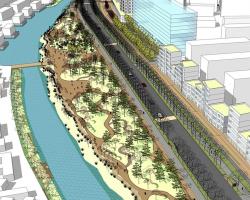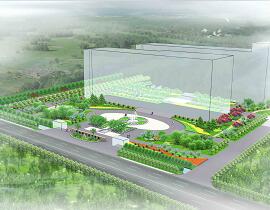摘要介绍了水生植物的类型,分析了其景观价值和生态意义,结合水生植物在泰州市园林水系中的应用情况,总结了目前泰州市水生植物应用中存在的问题,对水生植物在景观建设中的应用提出建议。
Types of aquatic plants was introduced in this paper, analyzes the landscape value and ecological significance, combining the application of aquatic plants in taizhou garden drainage situation, summarizes the problems existing in the taizhou aquatic plant application, the application of aquatic plants in landscape construction are proposed.
关键词水生植物;园林景观;应用;江苏泰州
Key words of aquatic plants; Landscape; Applications; Jiangsu taizhou
水生植物因其形态优美、色彩丰富、种类繁多,被广泛应用于城市园林水景布置中,它既能美化环境,又能净化水源,是现代园林造景中必不可少的材料[1,2]。随着园林建设科学性和文化内涵的提高,为适应建设园林城市、生态型园林城市的目标,城市景观绿化受到政府及公众的重视,水生植物的应用也越来越多。城市园林绿化日益发展,水生植物在城市绿化建设中将发挥越来越大的作用。水生植物的应用将不断扩大到公园景观、湿地保护、盆栽观赏、河道美化、水体净化、小区绿化等多方面。随着近几年来泰州市园林建设的发展,水生植物在泰州市园林景观中的应用呈现出蓬勃向上的良好发展态势,特别是新开发建设的凤城河景区和园博园工程,让泰州市民越来越多地享受到碧波荡漾、鸟语花香的自然美景。
Aquatic plants because of its shape is beautiful, rich color, variety, are widely used in city landscape waterscape is decorated in, it can not only beautify the environment, and can purify water, is indispensable in the modern landscape gardening materials [1, 2]. With the improvement of landscape construction is scientific and cultural connotation, in order to meet the construction of garden city and ecological garden city, urban landscape greening brought to the attention of the government and the public, also more and more application of aquatic plants. Urban landscape development, aquatic plants will play a growing role in urban greening construction. Application of aquatic plants will continue to expand the park landscape, wetland protection, ornamental plants, river water purification, landscaping, greening, etc. With the development of taizhou landscape construction in recent years, aquatic plant application in taizhou landscape showing a good development momentum of vigorous upward, especially the new development and construction of FengCheng river scenic area and park expo garden project, taizhou citizens increasingly enjoy rippling, charactizing a natural beauty.
1水生植物的类型
1 type of aquatic plants
水生植物泛指生长在水体环境中的植物。我国水系众多,水生植物资源丰富,仅高等水生植物就有300余种。根据最常见的园林水生植物分类方法,按其生活方式与形态特征可以将其分为挺水型、浮叶型、漂浮型及沉水型4种类型。
Aquatic plant refers to the plant grows in the aquatic environment. Drainage system in our country is numerous, aquatic plants rich in resources, there are more than 300 kinds of higher aquatic plants alone. According to the most common garden plants classification method, according to their lifestyle and morphological characteristics can be divided into a water type, floating leaf, floating and submerged type four types.
挺水类植物的根扎在泥中,茎叶挺出水面,有些种类具肥厚的根状茎或在根系中具有发达的通气组织,对水深适应性一般而言与植株高度有关,植株高大的适水能力稍强。再力花、芦苇、芦竹、水葱等高大植物适应水深可达60cm;慈菇、海寿花、黄菖蒲、香蒲、千屈菜等植株中等的植物适应55cm左右水深;花叶芦苇、玉婵花、灯心草、泽泻等适应水深在10~30cm。浮水类植物的根在泥中,叶片漂浮于水面或略高出水面,花开时近水面。这些植物的叶柄或茎、叶片的海绵组织较为发达,贮存有大量的空气。浮叶植物对水深的适应性一般来说较挺水植物要好,并且因种类而异,如芡实的适水深度达1.5m,菱可达3m,当植株生长到一定程度时可断根成为浮水植物,不再受水深限制。漂浮类植物的根系漂在水中,叶完全浮于水面,可随水漂移,在水面的位置不易控制。多数以观叶为主,它们既能吸收水里的矿物质,又能抑制水藻的生长,如浮萍、水鳖、凤眼莲等。沉水类植物的根扎在泥中,茎叶沉于水中,它与湖底水生植被的存在可阻止上层水体动力扰乱湿地底部,有效遏制底泥营养盐向水体释放,是净化水质或布置水下景观的优良植物材料。它们能够在白天制造氧气,有利于平衡水中的化学成分和促进鱼类的生长,如虎尾藻、金鱼藻、苦草等。
Quite water plants have roots in the mud, stem ye ting out of the water, some species with a fleshy rhizomes or have developed aerenchyma in root system, adapted to water depth generally associated with plant height, plant height of optimum water ability is a bit stronger. Force to spend again, reed, bamboo reed, scirpus tabernaemontani tall plants adapt to water depth up to 60 cm; Arrowhead, sea life of flowers, yellow calamus, cattail and willow plant medium plants adapt to 55 cm depth of water; Reeds Mosaic, jade chan flowers, bulrush, alisma, etc. To adapt to the depth of water in 10 ~ 30 cm. Floating plants have roots in the mud, leaves floating on or slightly above the surface of the water, the water bloom near surface. These plants of petiole or stem, leaf spongy tissue is relatively developed, storage there is plenty of air. Floating plant adaptability to water in general is pretty better water plants, and owing to the different types, such as Gordon euryale seed of water depth of 1.5 m, ling up to 3 m, when the plants grow to a certain degree can be a floating plants increased, no longer restricted by the depth of the water. Floating drift in the water the roots of the plants leaves floating in the water, can drift with the water, the water of the position is not easy to control. Most is given priority to with foliage, they can not only absorb the minerals in the water, and can inhibit the growth of algae, such as duckweed, water turtle, crassipes, etc. Submerged plants have roots in the mud, stem leaf drowned in the water, it has to do with the existence of the lake aquatic vegetation can prevent the upper water power disrupted at the bottom of the wetland, effectively curb sediment nutrient released to the water, is to purify the water quality or decorate good underwater landscape plant material. They can produce oxygen during the day, is conducive to balance the chemical composition and promote the growth of fish in the water, such as huwei, hornwort, bitter grass, etc.
2水生植物的景观价值和生态意义
2 water plants landscape value and ecological significance
2.1景观效果
2.1 landscape effect
水生植物不仅可以观叶、赏花、闻香,还能欣赏映照在水中的倒影。“浮香绕曲岸,圆影覆华池”、“波明荇叶颤,风热萍花香”等诗中描述的水生植物景致给人一种清新、舒畅之感。从空间角度来看,水体宽广时,易产生平淡的感觉。除了用亭、桥等构筑物分隔水面外,还可与水生植物和观赏植物相结合以丰富水面,并分隔不同质地的地面和围合空间。同时,在水环境中,采用在水体周围布植树林、草地,形成掩映、幽静的景观效果。
Aquatic plants can not only foliage, flowers, liquor, can appreciate its reflection in the water. "Floating around the shore, round shadow cover h chi", "Ming grass leaves quiver, wind hot ping of flowers", such as the poem describes the aquatic plant scenery give a person a kind of pure and fresh, comfortable feeling. From the Angle of space, water body is broad, easy to produce insipid feeling. Except with pavilions, Bridges and other structures separating the water, can also be combined with water plants and ornamental plants with rich water, and separated in different kinds of ground and surround close space. At the same time, in the water environment, using the cloth around the water tree forest, grassland, form and quiet landscape effect.
2.2生态价值
2.2 the ecological value
当前水资源不断减少,水生态环境遭受破坏日益严重,充分利用好水生植物对于改良水体、降低污染有显着作用。研究证明,水生植物可吸收、富集水中的营养物质及其他元素,可增加水体中的氧气含量或抑制有害藻类繁殖,遏止底泥营养盐向水中的再释放,利于水体的生物平衡等。水生高等植物能有效地净化富营养化湖水,提高水体的自净能力,也是人工湿地系统发挥净化作用必不可少的因素之一[3,4]。
The dwindling water resources, serious water damage to ecological environment, make full use of good aquatic plants for improved water, reduce pollution has significant effect. Research proves that aquatic plants can absorb the nutrients in the water, enrichment and other elements, can increase the oxygen content in water or inhibit harmful algal blooms, prevent sediment nutrient released again into the water, for water biological balance, etc. Can effectively purify the eutrophication of the lake aquatic higher plants, improve the water self-purification ability, also is the indispensable factors in constructed wetland system play a role of purification of [3, 4].
3水生植物在泰州市园林景观中的应用现状
3 the application status of aquatic plant in taizhou landscape
20世纪90年代初水生植物在泰州园林景观中的应用主要以荷花、睡莲为主。2005年,泰州市随着凤城河景区的开工建设,不断引进千屈菜、水葱、菖蒲、小香蒲、再力花、芦苇、芦荻、蒲苇等水生植物品种,翌年效果颇佳。目前凤城河风景区水生植物傍水而生,风姿秀逸,其与生俱来的天然恬静满足了人们渴望回归自然的愿望。2009年泰州市在省园博园建设中,从外地引进水生植物20余种,梭鱼草、西伯利亚鸢尾、灯芯草等被大量应用,挺水、沉水、浮叶、湿生植物交相错落、姿态万千,组成众多清新自然、景色怡人的水生植物景观。据初步统计,目前泰州市应用在园林中的水生植物达20余种
Aquatic plants in the early 1990 s application in taizhou landscape is mainly composed of lotus, water lily. In 2005, taizhou as FengCheng river scenic area construction, constantly introducing small willow, scirpus tabernaemontani, calamus, cattail, force again, reeds and rushes, pampas grass varieties of aquatic plants, the following effect is good. Currently FengCheng river scenic area aquatic plants alongside water, graceful message, its inherent natural quiet satisfied people eager to return to natural desire. Taizhou in the construction of provincial park expo garden in 2009, introduced from outside more than 20 species of aquatic plants, barracuda grass, Siberian iris, rushes by a large number of applications, such as a heavy water, water, floating leaf, photograph strewn at random, the intricacies of hygrophilous plants, consisting of pure and fresh and natural landscape of aquatic plants, has beautiful scenery. According to preliminary statistics, currently taizhou application amounted to more than 20 species of aquatic plants in garden
4存在的问题
4 the problems existing in the
近几年,水生植物在城市园林上的应用得到了较快发展,形成较为成型的水生系统,但由于水生植物在泰州市园林应用研究方面的准备严重不足,应用上主要存在以下一些问题。
In recent years, the use of aquatic plants in urban gardens has got rapid development, forming a molding of aquatic systems, but as a result of aquatic plant in taizhou landscape application research seriously insufficient, the main application on the following problems.
一是水生植物应用的物种多样性不够丰富。水生植物虽然种类达300余种,但在泰州市园林景观中应用的品种仅20余种,又以荷花、睡莲、再力花等少数品种居多。湿地景观千篇一律,缺乏层次感,使得水体景观无新意、缺乏地方特色,还有很多品种未被引种和驯化,大部分具有观赏价值的水生花卉如雨久花灯等还未被应用。常绿水生植物应用少,四季景观不匀,冬季水面景观单一。二是水生植物的景观配置过于单调。水生植物造景虽在近几年引起高度重视,发展较快,但从总体上来说,植物配置还比较机械和简单,不外乎块状、带状、组合状等几种形式的运用。水生植物的种类配置单调,从而缺乏层次感,使得水体景观无新意。水生植物种类单调会导致鸟类、鱼类缺少隐蔽栖息场所,造成整个水体生态缺乏生机,景观效果差。三是水生植物应用的配套支持不够。施工人员对水生植物的生长习性不甚熟悉,反季节施工损失较大。园林设计人员对水生植物了解不够,致其在设计中应用时比较保守,无法充分发挥出水生植物在水景工程中的作用。养护人员对水生植物的管理较为粗放,因缺乏经验,不能进行有效的修剪、施肥、病虫害防治等正常养护,从而导致水生植物生长不够健壮。目前还缺少专业的水生植物生产基地,基本依赖于从上海、杭州等外省市调入。四是对乡土水生植物的应用研究不够。目前缺乏对地方乡土水生植物资源的调查和开发应用研究。同时,对外来水生物种的危害性认识不足。如繁殖力极强的凤眼兰、大漂等,其净化水质功能尚未见效,确已疯长成灾。冬天,它们的躯体老化沉入水底,沉淀后成富营养化,造成二次污染。
One is the application of aquatic plants species diversity are rich enough. Aquatic plant species more than 300 kinds of, but in the applications of taizhou landscape only more than 20 kinds of varieties, such as lotus, water lily, and flowers again a few varieties in the majority. Wetland landscape monotony and lack of administrative levels feeling, make water body landscape without new idea, lack of local characteristics, there are many varieties are not introduction and domestication, most aquatic flowers and plants with ornamental value is like a long lanterns and so on has not yet been applied. Evergreen aquatic plant use less, the four seasons landscape uneven, single water landscape in winter. Second, the aquatic plant landscape configuration too drab. Aquatic plant landscaping cause attaches great importance to in recent years, rapid development, but overall, the plant configuration is relatively simple mechanical and, nothing more than the massive, banded, portfolio, etc. The use of several forms. Kinds of aquatic plants configuration drab, lack of administrative levels thereby, makes the water landscape without new idea. Aquatic plant species drab can lead to lack of hidden birds, fish habitats, causing the water ecological lack vitality, landscape effect is poor. Three is the application of aquatic plants to support enough. Construction personnel of aquatic plant growth habit is not very familiar with, anti-season construction loss is bigger. Garden designer know about aquatic plants is not enough, cause its application in the design is conservative, cannot give full play to the role of aquatic plants in water landscape engineering. Maintenance personnel to the management of aquatic plants is relatively extensive, due to lack of experience, can't effectively pruning, fertilization, plant diseases and insect pests prevention and control, such as normal maintenance, resulting in aquatic plant growth are robust enough. There is a lack of professional manufacturing base of aquatic plants, basic depends on the provinces and cities call in from Shanghai, hangzhou thereof. Four is enough for local application of aquatic plants research. Currently lack of local native aquatic plant resources investigation and development of applied research. At the same time, inadequate recognization of the danger of invasive aquatic species. Such as fertility extremely strong water hyacinths, bleaching, etc., the ability of purifying water quality, have been growing. In winter, they body aging sank to the bottom, after precipitation into eutrophication, causing secondary pollution.
5加快发展泰州市水生植物的建议
May speed up the development of taizhou aquatic plant suggestion
5.1水生植物品种的多样化
5.1 varieties of aquatic plants
园林绿化部门应收集整理和开发利用好乡土水生植物。在筛选时应注意选择观赏价值高、管理粗放、适应性强的水生植物,充分利用好本土化、乡土化的水生野生群落资源。同时,加强新优水生植物的引种,对试种成功的品种加以推广和应用。园林部门应及时了解国内外新品种信息,按照适地的原则进行引进,重点引种驯化耐寒、耐水湿、管理粗放、观赏价值高、适应性强的园林水生植物。由此而建立平衡稳定的生态系统,考虑物种的多样性和水体景观的层次化,为鸟类、鱼类提供隐蔽、栖息的场所,共建和谐生态环境。
Landscaping department should collect and good development and utilization of local aquatic plants. With higher ornamental value should be paid attention to during the screening of aquatic plants, extensive management, strong adaptability, make good use of localization, local-color aquatic wild community resources. At the same time, strengthen the new optimal introduction of aquatic plants, the trials are successful varieties to promotion and application. Garden department should be informed of new information at home and abroad, according to the principle of the right to import and key domesticated hardy, resistance to wet, management extensive, high ornamental value and strong adaptability of garden plants. Which establish stable balance of ecological system, considering the diversity of species and water landscape hierarchical, provide shelter for birds, fish, perched place, to build a harmonious ecological environment.
5.2水体植物配置的艺术性
5.2 water plant configuration of the artistic quality
在水体植物配置上应通过艺术的构图原理,体现水生植物个体和群体的形式美。自然的水体配置的水生植物宜高低错落,沿水岸边缘或丛植或点植,植物的色彩、体量及线条可多变,忌裙边式种植,规则式的水体宜在水体中围合规则的种植槽,槽内水生植物不宜过多,以防植物蔓延破坏整体景观。曲折溪流的配置手法较为特别,对植物的品质、色彩、线条要求也高,种植时还需考虑卵石的摆放,通常定位在点植的植物之前,以减缓流动的水体对水生植物长期冲击产生的不利影响。在植物品种配置上,构成挺水、沉水相呼应,水生、陆生相协调的植物配置格局。种类配置时还应注意与耐水湿的乔灌木及色叶树种的配置。如荷柳组合,荷竹组合,或水杉、落羽杉、水松等位背景。总之,水生植物的配置与环境达到和谐、自然、舒适为宜。
On the water plant configuration should be through art, the composition principle of form of aquatic plant individual and group. Natural water body configuration of aquatic plants should be strewn at random discretion, or clump planting along the water front edge or point of plant, plant colour, size and line can be changeable, avoid skirt BianShi planting, the rules of water should be in the water surrounding the growing rules of groove, groove aquatic plant shoulds not be too much, will prevent the spread of the plants, destroy the landscape as a whole. Winding stream has a special configuration technique, quality, colour, line requirements for plant is high, also need to consider when planting of pebble put, usually located before the point of the plants, to slow the flow of water have adverse effects on aquatic plant long-term impact. On the varieties of plant configuration, constitute a water sink, photograph echo, coordinated aquatic, terrestrial plants configuration pattern. Type configuration should also pay attention to waterproof wet ba color leaf tree species configuration. Such as load combination, lotus bamboo combination, or the metasequoia glyptostroboides, swamp, taxus allelic background. In a word, configuration of aquatic plants and the environment it is advisable to achieve a harmonious, natural, comfortable.
5.3水生植物适应性的研究
5.3 adaptability study of aquatic plant
园林技术人员要了解水生植物的生长习性和水文条件,满足其与环境在生态适应上的统一。如果园林景观设计人员对水生植物的生长习性及水深适应性缺乏认识,职业敏感性较差,会使水生植物得不到预期效果。种植施工时应按照不同植物的生态习性,水深情况及水位变化等设置深水区、中水区、浅水区栽植。如睡莲等适应于1.2m左右深水区生长,香蒲、花叶芦荻等适应在20~30cm浅水区生长,鸢尾、千屈菜等可在水陆交界区生长。不同的植物对水位要求也存在差异,如睡莲栽植后,保持水深在50~60cm,当叶子浮出水面后,随着植物的生长需要逐渐提高水位,开花期保持水深70~80cm,结冰前一定要加升水位,水的深度稳定在90~100cm,这样睡莲才能安全越冬。通常水生植物面积应为水面总面积的1/3~2/5,不宜过于拥挤,水景形成后,随着水生植物的不断生长、分蘖,水面会越来越拥挤,这就需要人工修剪、抽稀,必要时还可在水底用砖石围堰,以防其地下茎蔓延。只有保持一定的空荡水面,才能重现水波涟漪的美景。
Landscape technicians to understand the growth habit of aquatic plants and hydrological conditions, satisfy with the environment in the unity on the ecological adaption. If the landscape design of aquatic plant growth habit and lacks the understanding depth of adaptability, poor sensitivity, can make the aquatic plants can not get the desired effect. Plant construction should according to different plant ecological habits, the depth of the water situation and the change of water level set up in the deep water area, water area, shallow water plant. Such as water lily adapted to the growth of about 1.2 m deep water area, cattail, Mosaic, they adapt to grow in the 20 ~ 30 cm shallow water, such as iris, willow, etc can grow in the border land and water area. Different plants for water level is different, such as the water lily after planting, keep the water depth in 50 ~ 60 cm, after the leaf surface, along with the growth of plants need to gradually improve level, flowering period to maintain water depth of 70 ~ 80 cm, must add premium before freezing, the depth of the water stability in 90 ~ 100 cm, so that water lily can safe overwintering. Usually aquatic plant area shall be the total area of the surface of 1/3 ~ 2/5, shoulds not be too crowded, waterscape form, with the growth of aquatic plants, tillering, the surface will be more and more crowded, which requires artificial pruning, thin, when necessary, also can be in the bottom with stones cofferdam, prevent the spread of the its rhizome. Only keeping empty the water, to reproduce the beauty of the waves ripple.





